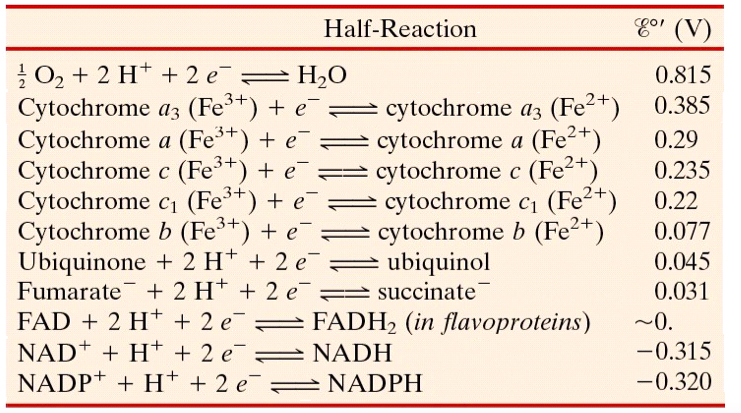The table below shows the standard reduction potential of some biochemical reactions. As per the table, the molecule that would most readily undergo reduction is a) H2O b) O2 c) NADH d) NAD
The table below shows the standard reduction potential of some biochemical reactions. As per the table, the molecule that would most readily undergo reduction is a) H2O b) O2 c) NADH d) NAD
Principles of Instrumental Analysis
7th Edition
ISBN:9781305577213
Author:Douglas A. Skoog, F. James Holler, Stanley R. Crouch
Publisher:Douglas A. Skoog, F. James Holler, Stanley R. Crouch
Chapter14: Applications Of Ultraviolet-visible Molecular Absorption Spectrometry
Section: Chapter Questions
Problem 14.13QAP: Copper(II) forms a 1:1 complex with the organic complexing agent R in acidic medium. The formation...
Related questions
Question
The table below shows the standard reduction potential of some biochemical reactions. As per the table, the molecule that would most readily undergo reduction is
a) H2O
b) O2
c) NADH
d) NAD+

Transcribed Image Text:Half-Reaction
Eo' (V)
O, + 2 H* + 2 e =H,O
Cytochrome az (Fe**) + e¯= cytochrome az (Fe2+)
Cytochrome a (Fe**) + e
Cytochrome c (Fe**) + e
Cytochrome c, (Fe**) + e
Cytochrome b (Fe³+) + e¯
Ubiquinone + 2 H* +2 e =
Fumarate + 2 H* + 2 e succinate
FAD + 2 H+ + 2 e
NAD+ + H+ + 2 e
NADP+ + H* + 2 e
0.815
3-
0.385
= cytochrome a (Fe2+)
cytochrome c (Fe²+)
= cytochrome c (Fe2+)
cytochrome b (Fe²+)
ubiquinol
0.29
0.235
0.22
0.077
0.045
0.031
FADH2 (in flavoproteins)
~0.
NADH
-0.315
|
= NADPH
-0.320
Expert Solution
This question has been solved!
Explore an expertly crafted, step-by-step solution for a thorough understanding of key concepts.
This is a popular solution!
Trending now
This is a popular solution!
Step by step
Solved in 3 steps

Knowledge Booster
Learn more about
Need a deep-dive on the concept behind this application? Look no further. Learn more about this topic, chemistry and related others by exploring similar questions and additional content below.Recommended textbooks for you

Principles of Instrumental Analysis
Chemistry
ISBN:
9781305577213
Author:
Douglas A. Skoog, F. James Holler, Stanley R. Crouch
Publisher:
Cengage Learning


Principles of Instrumental Analysis
Chemistry
ISBN:
9781305577213
Author:
Douglas A. Skoog, F. James Holler, Stanley R. Crouch
Publisher:
Cengage Learning
